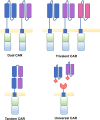How Can We Engineer CAR T Cells to Overcome Resistance?
- PMID: 34040345
- PMCID: PMC8141613
- DOI: 10.2147/BTT.S252568
How Can We Engineer CAR T Cells to Overcome Resistance?
Abstract
Chimeric antigen receptor (CAR) T cell therapy has achieved unrivalled success in the treatment of B cell and plasma cell malignancies, with five CAR T cell products now approved by the US Food and Drug Administration (FDA). However, CAR T cell therapies for solid tumours have not been nearly as successful, owing to several additional challenges. Here, we discuss mechanisms of tumour resistance in CAR T cell therapy and the emerging strategies that are under development to engineer CAR T cells to overcome resistance.
Keywords: T-cell; cancer; chimeric antigen receptor; immunotherapy; resistance.
© 2021 Glover et al.
Conflict of interest statement
JM is founder, chief scientific officer and shareholder in Leucid Bio. MG is an employee and shareholder in Leucid Bio. The authors report no other conflicts of interest in this work.
Figures



Similar articles
-
Paediatric Strategy Forum for medicinal product development of chimeric antigen receptor T-cells in children and adolescents with cancer: ACCELERATE in collaboration with the European Medicines Agency with participation of the Food and Drug Administration.Eur J Cancer. 2022 Jan;160:112-133. doi: 10.1016/j.ejca.2021.10.016. Epub 2021 Nov 25. Eur J Cancer. 2022. PMID: 34840026 Review.
-
Challenges in the Treatment of Glioblastoma by Chimeric Antigen Receptor T-Cell Immunotherapy and Possible Solutions.Front Immunol. 2022 Jul 7;13:927132. doi: 10.3389/fimmu.2022.927132. eCollection 2022. Front Immunol. 2022. PMID: 35874698 Free PMC article. Review.
-
Challenges and Prospects of Chimeric Antigen Receptor T-cell Therapy for Metastatic Prostate Cancer.Eur Urol. 2020 Mar;77(3):299-308. doi: 10.1016/j.eururo.2019.08.014. Epub 2019 Aug 28. Eur Urol. 2020. PMID: 31471138 Review.
-
The Great War of Today: Modifications of CAR-T Cells to Effectively Combat Malignancies.Cancers (Basel). 2020 Jul 24;12(8):2030. doi: 10.3390/cancers12082030. Cancers (Basel). 2020. PMID: 32722109 Free PMC article. Review.
-
Insight into next-generation CAR therapeutics: designing CAR T cells to improve clinical outcomes.J Clin Invest. 2021 Jan 19;131(2):e142030. doi: 10.1172/JCI142030. J Clin Invest. 2021. PMID: 33463538 Free PMC article. Review.
Cited by
-
CAR Based Immunotherapy of Solid Tumours-A Clinically Based Review of Target Antigens.Biology (Basel). 2023 Feb 10;12(2):287. doi: 10.3390/biology12020287. Biology (Basel). 2023. PMID: 36829563 Free PMC article. Review.
-
Resistance against anti-CD19 and anti-BCMA CAR T cells: Recent advances and coping strategies.Transl Oncol. 2022 Aug;22:101459. doi: 10.1016/j.tranon.2022.101459. Epub 2022 May 23. Transl Oncol. 2022. PMID: 35617812 Free PMC article. Review.
-
The role of CD4+ CAR T cells in cancer immunotherapy.Transl Cancer Res. 2024 May 31;13(5):2580-2586. doi: 10.21037/tcr-23-2044. Epub 2024 May 17. Transl Cancer Res. 2024. PMID: 38881935 Free PMC article. No abstract available.
-
CAR-Based Immunotherapy of Solid Tumours-A Survey of the Emerging Targets.Cancers (Basel). 2023 Feb 11;15(4):1171. doi: 10.3390/cancers15041171. Cancers (Basel). 2023. PMID: 36831514 Free PMC article. Review.
-
Chimeric Antigen Receptor (CAR) T-Cell Therapy for Patients with Lung Cancer: Current Perspectives.Onco Targets Ther. 2023 Jul 3;16:515-532. doi: 10.2147/OTT.S341179. eCollection 2023. Onco Targets Ther. 2023. PMID: 37425981 Free PMC article. Review.
References
-
- Eshhar Z, Waks T, Gross G, Schindler DG. Specific activation and targeting of cytotoxic lymphocytes through chimeric single chains consisting of antibody-binding domains and the gamma or zeta subunits of the immunoglobulin and T-cell receptors. Proc Natl Acad Sci U S A. 1993;90(2):720–724. doi:10.1073/pnas.90.2.720 - DOI - PMC - PubMed
-
- Finney HM, Lawson AD, Bebbington CR, Weir AN. Chimeric receptors providing both primary and costimulatory signaling in T cells from a single gene product. J Immunol. 1998;161(6):2791–2797. - PubMed
-
- Schuster SJ, Bishop MR, Tam CS, et al. Tisagenlecleucel in adult relapsed or refractory diffuse large B-cell lymphoma. N Engl J Med. 2019;380(1):45–56. - PubMed
Publication types
Grants and funding
LinkOut - more resources
Full Text Sources
Other Literature Sources

